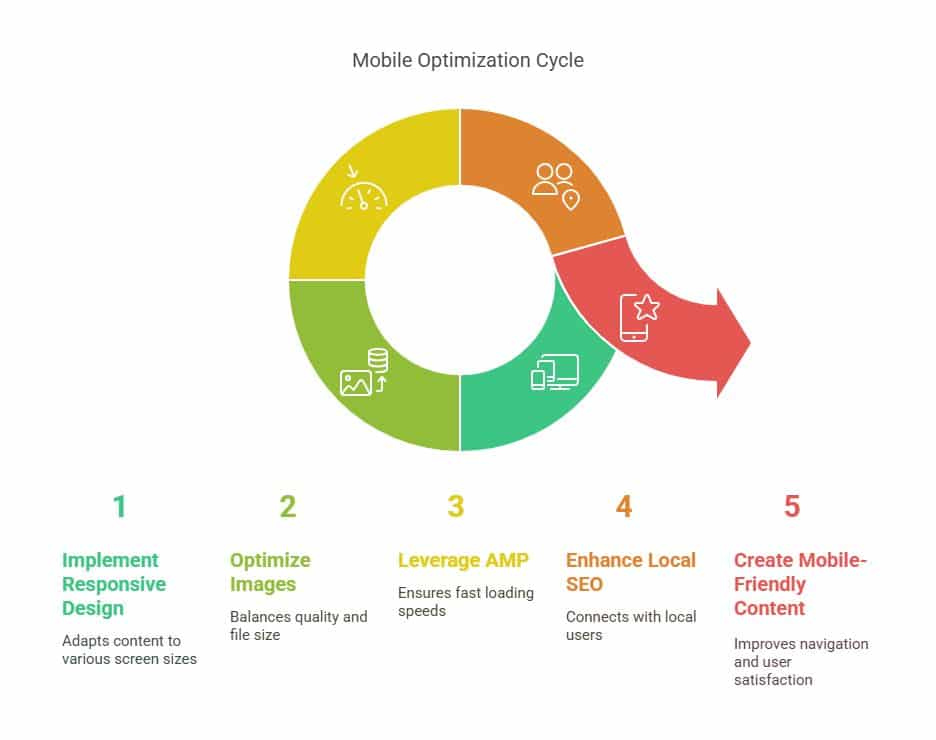
3 Key Techniques for Mobile SEO Optimization
Improving mobile SEO requires implementing several essential strategies for better search visibility. Prioritize site speed improvements through efficient image handling and browser caching to minimize loading delays. Implement responsive design solutions that seamlessly adapt your content across different mobile devices. Take advantage of local SEO opportunities by optimizing your mobile presence for nearby searches. This comprehensive guide to mobile SEO optimization techniques ensures better user experience while meeting search engine requirements, providing valuable insights for implementation.
Key Takeaways
- Implementing responsive design ensures your content seamlessly adapts across all screen sizes, creating a perfect viewing experience from smartphones to tablets and beyond.
- Smart image compression finds the sweet spot between visual impact and file size, keeping your pages loading quickly without sacrificing quality.
- Leveraging AMP technology delivers lightning-fast loading speeds that keep your mobile visitors engaged rather than waiting impatiently.
- Fine-tuning your local search optimization connects you with nearby users actively searching for services, making your business instantly discoverable.
- Creating mobile-friendly content with intuitive navigation makes it effortless for users to find what they need while keeping search engines satisfied.

1. Enhancing Mobile Site Speed
In today’s mobile SEO landscape, the critical factor of site speed directly influences both user experience and search performance. At the heart of speed optimization lies strategic image optimization, where smart compression techniques work to minimize load times without quality loss. This approach forms the foundation of superior mobile usability, ensuring visitors stay engaged and connected with your content.
One key strategy involves AMP implementation, also known as Accelerated Mobile Pages. This innovative framework allows for the development of streamlined web pages that drastically reduce loading time on smartphones and tablets. When businesses leverage AMP to enhance their site’s performance, they not only boost their mobile accessibility but also increase their chances of climbing higher in search rankings.
Caching strategies also play a pivotal role in enhancing mobile site speed. By storing data locally, caching reduces the time needed to retrieve information on repeat visits, thus improving the efficiency and speed of mobile sites. This not only enhances user experience but also conserves bandwidth, which is particularly beneficial for users on limited data plans.
Finally, ensuring that touch targets are appropriately sized and spaced is essential for mobile usability. Touch targets refer to the interactive elements on a mobile site, such as buttons and links. If these elements are too small or too close together, users may struggle to interact with the site efficiently, leading to frustration and potential site abandonment.
Therefore, optimizing touch targets contributes to a more user-friendly interface, encouraging longer visits and positive interactions with the site.
2. Leveraging Responsive Design

How can businesses ensure their websites provide a seamless experience across all devices? The answer lies in leveraging responsive design, a critical aspect of mobile SEO optimization. Responsive design ensures that a website automatically adjusts its layout and elements based on the device’s screen size and orientation, thereby enhancing mobile usability. This adaptability is crucial as it allows users to easily navigate and interact with the website, regardless of whether they are using a smartphone, tablet, or desktop computer.
To achieve optimal responsive design, businesses must pay close attention to viewport settings. The viewport meta tag helps control the width and scaling of a webpage, making it possible to render content appropriately on different devices. Properly configured viewport settings are foundational to ensuring that touch interactions are intuitive and seamless, enhancing the overall user experience.
Content prioritization is another vital component of responsive design. With limited screen real estate on mobile devices, it is essential to prioritize the most critical content, ensuring it is easily accessible and legible. By doing so, businesses can improve mobile accessibility, ensuring that users can quickly find the information they need without unnecessary scrolling or zooming.
Incorporating these elements into a cohesive responsive design strategy not only improves the user experience but also positively impacts search engine rankings. Search engines favor websites that offer excellent mobile usability and accessibility, leading to increased visibility and potential customer engagement.
3. Local SEO for Mobile Users

Responsive design sets the stage for enhancing user experience, but to truly harness the power of mobile SEO, businesses must also focus on local SEO for mobile users. As mobile devices become the primary tool for searching, local search optimization becomes indispensable. Mobile users frequently seek out local businesses, services, and information, making it crucial to appear in local search results.
Local SEO for mobile users involves optimizing for voice queries, as these have become increasingly popular. Users often employ voice assistants to find nearby establishments, which means businesses must ensure their information is accurate and up-to-date on platforms like Google My Business. This enhances visibility in local search results, catering to voice-driven inquiries.
Mobile friendly content is another critical component. Websites should load quickly and be easy to navigate on smaller screens, as this impacts user engagement and search rankings. A seamless mobile experience encourages users to remain on the site longer, increasing the likelihood of converting searches into visits.
App indexing is also a key factor in local SEO. By allowing search engines to index app content, businesses can appear in searches even if users haven’t installed their app. This approach broadens the reach of local businesses and provides an additional avenue for engagement.
Lastly, geo targeted ads offer a strategic advantage by delivering advertisements to users based on their geographic location. This ensures that ads are relevant and timely, increasing the likelihood of attracting local customers.
Final Thoughts
Mastering mobile SEO optimization is no longer optional in today’s digital landscape – it’s a necessity for business success. By implementing robust site speed improvements, embracing responsive design principles, and capitalizing on local SEO opportunities, businesses can create a powerful mobile presence that serves both users and search engines effectively. The key to success lies in adopting a holistic approach that combines technical optimization with user-centric design, ensuring that your mobile site not only ranks well but also delivers the seamless experience that modern users demand.
If you’re ready to take your mobile SEO strategy to the next level, Syville Gacutan, an experienced SEO Specialist in the Philippines, can help. With expertise in site speed optimization, responsive design, and local SEO, Syville can guide your business toward better search visibility and enhanced user experience. Don’t miss the opportunity to boost your mobile presence – connect with Syville today.